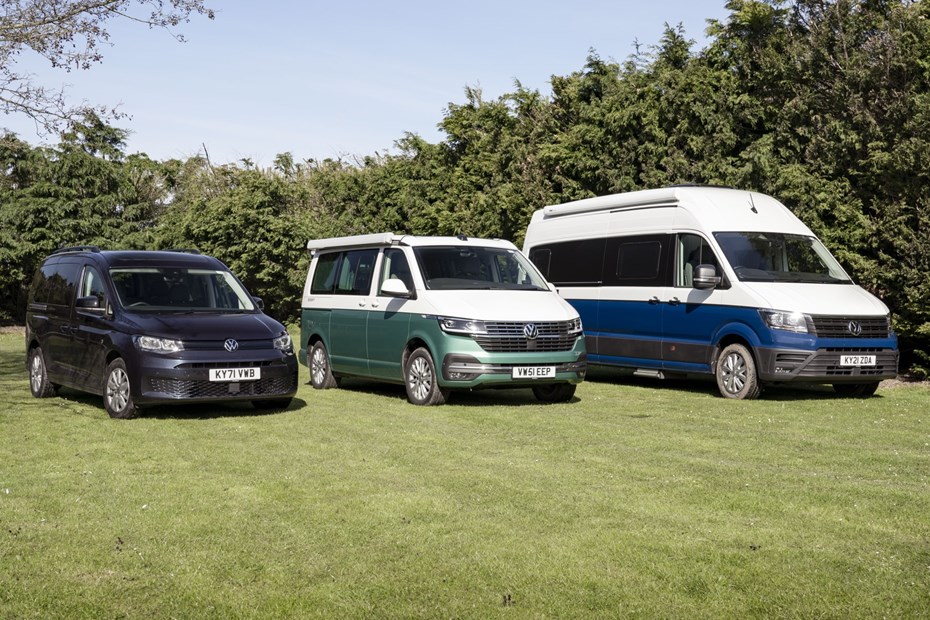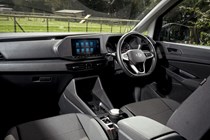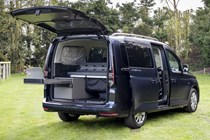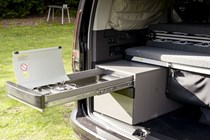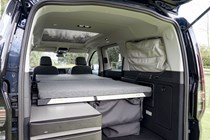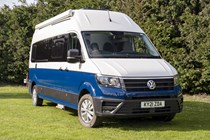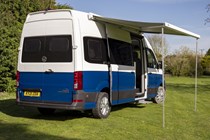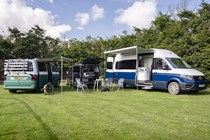These three campervans make up an arm of Volkswagen that’s been hugely successful and arguably more interesting than any of its passenger cars. Welcome, the California model range – from smallest to largest, consisting of the Caddy California, the California, and the Grand California.
The Volkswagen campervan has been an icon ever since the T1 Transporter in the 1950s – but it was in 2005 that things got really interesting.
The 70-year history of the VW Transporter
That was the year when Volkswagen, buoyed by the success of its Transporter van and its unbreakable link to vanlife and the camper sector in general, decided it wanted to do more than just supply the base vehicle for other companies to fit out – it wanted to build campervans itself. A dedicated factory in Hanover, Germany was fitted out, and the Volkswagen California was born.
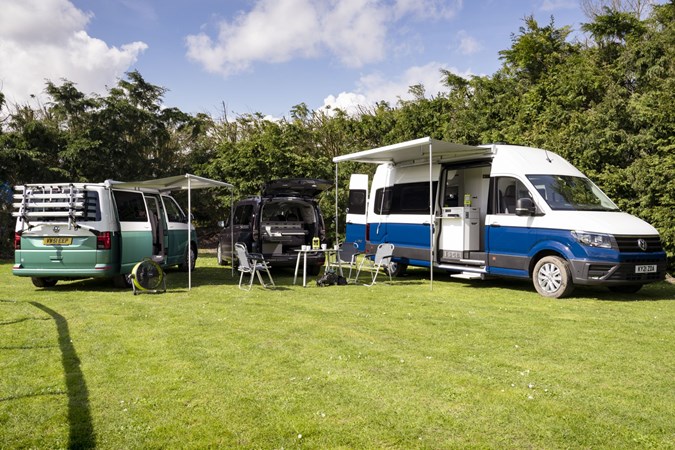
Many years on and the California’s been a huge success for Volkswagen, attracting customers who might not even have considered a camper before. It’s been so successful, in fact, that it’s been joined by both a Grand California and a Caddy California. The former is larger – based on the Volkswagen Crafter, it launched in 2019 to provide greater luxury to those who wanted a bigger van with more facilities.
New for this year is the Caddy California – it’s the size of a passenger car, seats five, and promises to be the ultimate accessory for the adventurous and young-at-heart.
We’ve got all three of them together here for the ultimate head-to-head.
Why buy a Volkswagen California?
The advantages of buying a van direct from Volkswagen are twofold. Firstly, there’s the vans themselves.
Being built from the ground up by a single company means these vehicles are cohesive, beautifully finished and feel incredibly premium. Features can be bundled together into one control panel – where on a third-party conversion you’d likely have separate panels for the lights, the space heater, water system and whatever other systems are fitted.
The Californias don’t feel as though they’re a van with camping equipment crammed inside – they feel like they were built from the ground up, which of course is the case.
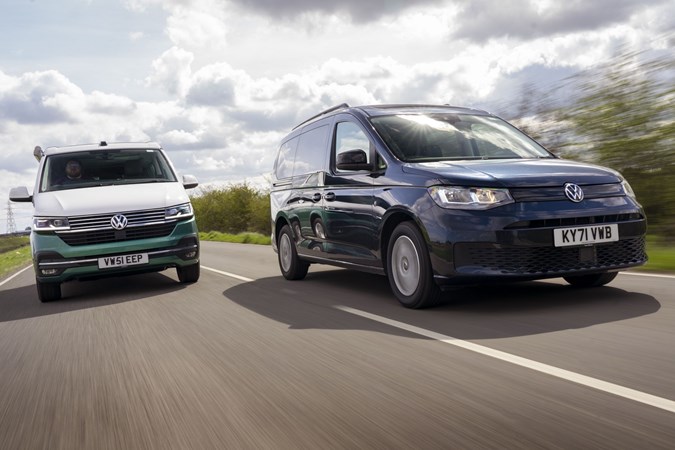
The other benefit is in ease of ownership. Buying, financing, servicing and maintaining a VW California takes place through a Volkswagen Van centre. With a third party conversion, the chances are you’d buy it and service the conversion through a motorhome dealer, visit the base vehicle’s dealer for servicing the mechanicals and finance through your bank or a dedicated finance company. That’s a lot of plates to keep spinning.
What are the disadvantages to a Volkswagen California?
Again, there are two main ones – but these may or may not bug you. The first is a lack of configurability. When you buy a third-party motorhome, you can tailor it to your liking – with a vast number of furniture layouts, berths, additional or reduced equipment according to your needs. The Californias don’t offer this, and limit you to the five layouts currently on offer, plus a few items off the options list.
This means if you have additional needs, like requiring space for a wheelchair or if you want separate beds, you can’t adjust the vans.
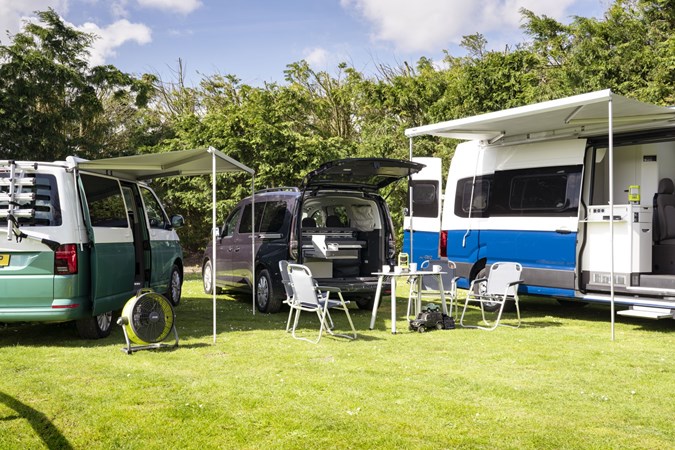
The other is cost. VW Californias are expensive – especially if you compare them with more budget conversions, or those that take place on used vans. A pricey base vehicle and high-quality conversion means Volkswagen can charge top dollar for its campers, and it knows people will pay it. That used values are so strong is testament to the desirability of the California range.
Which Volkswagen California is right for me?
We have detailed reviews of all three California models on Parkers.co.uk, and you can read those if you want more detail. Here we’ll briefly run through each van, though, and why you might prefer one over the other two…
VW Caddy California

This is the smallest California you can buy, based on the smallest van in Volkswagen’s range – the Caddy Cargo. The Caddy’s footprint is around the same as that of a Golf, so the Caddy California’s as compact as a car and just as easy to drive. It’s remarkably versatile, too, despite being so much smaller than its siblings.
The Caddy California’s available with petrol or diesel engines, and with six-speed manual or seven-speed automatic gearboxes. The automatic’s well worth considering, as is the petrol – the former takes the sting out of long journeys or city traffic, while the latter is smoother and quieter than the diesel at the expense of fuel economy.
In the cab, you’d barely know the Caddy California was a camper. It has five proper seats, one more than its siblings, plus twin sliding doors and loads of leg and headroom – making it perfect for use as a family car during the week. The dashboard is very car-like, clustered around a central touchscreen which is slick to look at if quite frustrating to use at times.

Round the back’s where the fun begins – you’ll find a clever pull-out kitchenette unit, storage for two chairs and a table and, most excitingly, the folded-up frame of a properly luxurious double bed. Extend this out over the folded (or removed) back seats and all of a sudden your practical five-seater van has a bed two metres long and over a metre wide.
Coming soon is a driveaway awning that will sit over the rear of the van, allowing you to use the kitchenette under cover and giving you some much-needed lounging space, as the van’s interior isn’t set up for relaxing unless you’re in bed.
Who’s the Volkswagen Caddy California best for?
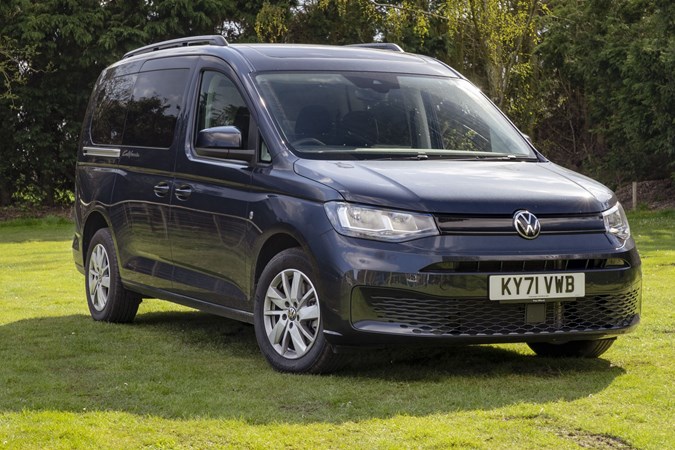
It’s the cheapest, with prices starting at less than £32,000, and the smallest, so it’s perfect for those who don’t want the commitment a full-sized van entails and perhaps need something they can use as a car during the week.
With a comfy bed but no other real luxuries, it’s definitely aimed at more active owners, maybe those who’ll sling a bike or kayak on the roof bars and use it for sporting pursuits. However, once the driveaway awning is available, the Caddy California has potential to be a family van, too.
VW California
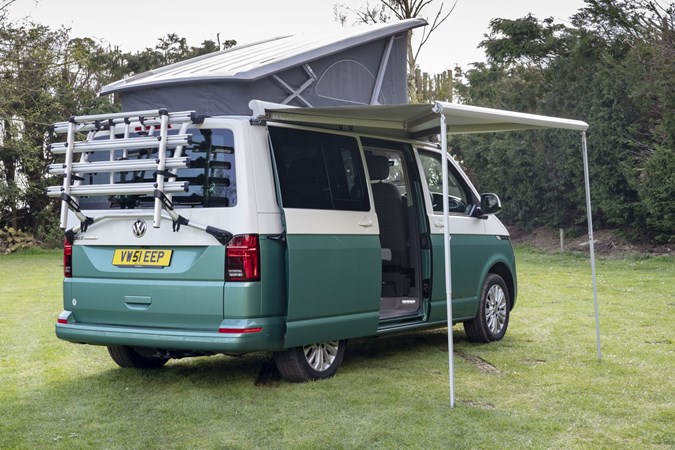
Based on the T6.1 Transporter, this is what most people will think of if you say ‘Volkswagen Camper’. It’s a great platform to start from. The Transporter is comfortable and smooth to drive – all models come with VW’s 2.0-litre TDI diesel and a DSG automatic gearbox, while top-spec vans get a digital dashboard, adaptive cruise control and even the option of adaptive dampers.
Inside, it’s classic camper – a side-mounted kitchen with two gas burners, a sink and fridge, plus plenty of storage in useful shelved cupboards. The lower bench forms one double bed, while the other is in the pop-top (electrically-operated, no less) – both are big enough for two to sleep comfortably.

The California’s packed with the sort of clever touches third-party converters can’t touch. Everything, from the heating and lighting to the operation of the pop-top, is controlled from a simple touchscreen panel on the roof between the swivelling front seats. It’s so easy to use, and makes other systems seem comically outdated.
Smart additions include the two outdoor chairs that store within the tailgate itself and the outdoor table that stores in the sliding door – both saving a lot of space. The top-loading fridge means you’ve also got plenty of cupboard space for food and kitchen gear.
Who’s the Volkswagen California best for?
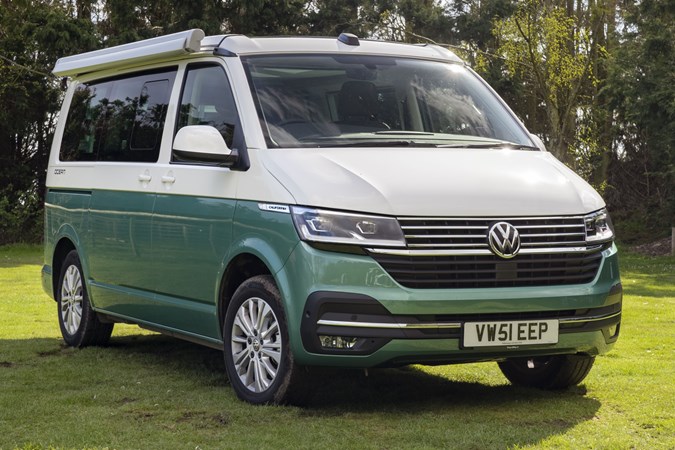
This is a true multi-purpose vehicle. With four seats, a sliding rear bench and a big boot area, you can use this for family transport, a trip to the tip or flat-pack furniture store or even for commuting. But it’s best on holiday, where it’s suitable for four but best for couples. Sit yourself on a campsite, roll out the awning, prepare yourself for an al fresco dinner and you’ll have a wonderful time.
The California is not cheap, but it holds its value very well – buy one now and you’ll be able to enjoy it for many years to come.
Volkswagen Grand California

If you’re after the ultimate in luxury vanlife, it has to be the Grand California. It’s based on the Volkswagen Crafter, and available in two formats – the 600, which is shorter but taller and sleeps four, or the 680, which is longer, lower, and set up as ultimate luxury for two people. It requires a higher category on your licence than the 600, though.
Regardless of layout, both have a 2.0-litre diesel engine and eight-speed automatic gearbox. They’re incredibly easy to drive for such large vehicles, but do require a bit of recalibrating in town – watch out for height restrictions, and don’t expect to be able to park up front in the supermarket.
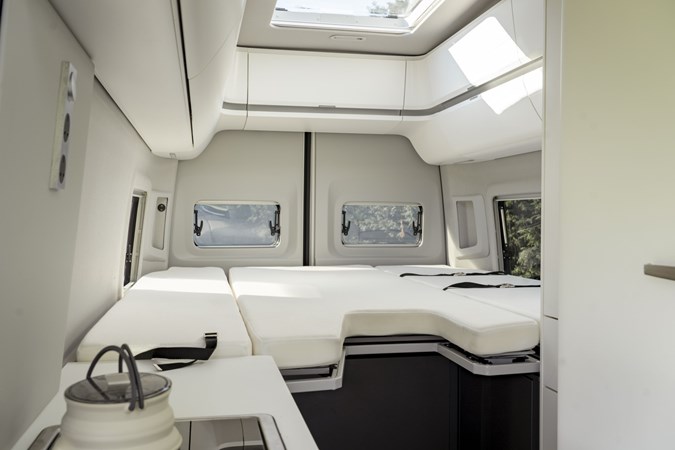
Up front, you’ll find a lounge, plus a side-mounted kitchen with a clever pull-out fridge, but the real point of difference here is the midships washroom. A cassette toilet, tip-up basin and full-sized shower mean this is the only California that you can take off the grid, instead of having to stay at serviced campsites.
Taller campers will be much better serviced by the 680, in which you sleep lengthwise – the 600’s main double bed is across the van and if you’re much over six foot you might find yourself a bit cramped. But it’s the only area of the van that feels cramped – there’s tons of storage for smaller items in cupboards above the bed or in larger units below it.
Who’s the Volkswagen Grand California best for?

This is for house mouses who intend to spend a lot of time in their van when they go on holiday. Great for long tours or venturing off the grid, the Grand California isn’t quite as versatile as its smaller siblings mainly due to its size – you’ll need a huge driveway to store it, and don’t expect to be regularly nipping out to the supermarket.
You’ll probably need to supplement the Grand California with a couple of bikes, so you can set it up on site but still go out exploring. Of course, you’ll need a big budget to buy one in the first place – but it’s money well spent.
Verdict
These are three fabulous campers, and the advantages of buying directly from Volkswagen are clear – even if you do have to pay a lot for the privilege.
We’d recommend the Caddy California to active, mobile campers who enjoy adventure and might not have the budget for an ultra-luxurious van, while the Grand California’s perfect for taking things more slowly – it’s big, comfortable, and has everything you need for a trip away in one self-contained package.
For us, though, it’s the standard California that provides the absolute best of both worlds, being small enough to use for daily duties but with enough space and versatility to make holidays a pleasure.
Just so you know, we may receive a commission or other compensation from the links on this website - read why you should trust us.


